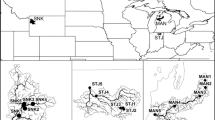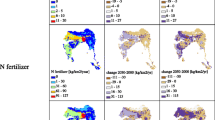Abstract
The Apure River is a major white-water tributary of the Orinoco River in Venezuela. The Apure is rich in solutes; its contribution to dissolved inorganic solids in the Orinoco (24%) is proportionately much greater than its contribution to discharge (6%). About 40% of the calcium and bicarbonate at the mouth of the Orinoco originate in the Apure drainage. The relationship between discharge and the concentrations of major solutes in the Apure was characterized with a two-compartment hyperbolic mixing model. Previous applications of the two-compartment model have been based on separate determinations of the model parameter β, which is a constant describing watershed hydrology, for each solute from data on concentrations. The use of a weighted mean β for all solutes is proposed as a means of assessing the importance of processes other than mixing. The model, when used on the Apure data, shows that a strong dilution effect prevails for sodium, calcium, magnesium, sulfate, and bicarbonate, and that a strong purging effect (increase of concentration with increasing discharge) is characteristic of soluble silicon. Biological immobilization of soluble silicon by diatoms during the season of low discharge is sufficiently large to account for the positive relationship between discharge and the concentration of soluble silicon. Specific transport rates of solutes from the basin are generally higher than global averages. In contrast, specific transport of chloride is low. Atmospheric sources control chloride transport in the Apure watershed; the low transport rates of chloride are probably explained by the great distance between the Apure watershed and the oceanic sources of atmospheric chloride.
Similar content being viewed by others
References
Armstrong FAJ & Butler EI (1962) Chemical changes in seawater off Plymouth during 1960. J. Mar. Biol. Assoc. UK. 42: 253–258
Bailey-Watts AE & Lund JWG (1973) Observations on a diatom bloom in Loch Leven, Scotland. Biol. J. Linn. Soc. 5 (3): 235–253
Edwards AMC (1973) The variation of dissolved constituents with discharge in some Norfolk rivers. J. Hydrol. 18: 219–242
Gibbs RJ (1970) Mechanisms controlling world water chemistry. Science 170: 1088–1090
Hall FR (1970) Dissolved solids-discharge relationships. I. Mixing models. Water Resources Res. 6: 845–850
Hamilton SK & Lewis WM Jr. (1987) Causes of seasonality in the chemistry of a lake on the Orinoco River floodplain, Venezuela. Limnol. Oceanogr. 32: 1277–1290
Johnson NM, Likens GE, Bormann FH, Fisher DW & Pierce RS (1969) A working model for the variation in streamwater chemistry at the Hubbard Brook Experimental Forest, New Hampshire. Water Resources Res. 5: 1353–1363
Kennedy VC (1971) Silica variation in stream water with time and discharge. In: Gould RF (Ed) Nonequilibrium Systems in Natural Water Chemistry (pp 94–130) Advances in Chemistry Series, 106
Lesack LR, Hecky RE & Melack JM (1984) Transport of carbon, nitrogen, phosphorus, and major solutes in the Gambia River, West Africa. Limnol. Oceanogr. 29: 816–830
Lewis WM Jr & Saunders JF, III (1988) Primary production in the Orinoco River. Ecology 69: 679–692
Lewis WM Jr & Saunders JF, III (1988) Concentration and transport of dissolved and suspended substances in the Orinoco River. Biogeochemistry (in press)
Lewis WM Jr. & Saunders JF, III (1989) Chemistry and element yields of the Orinoco main stem and lower tributaries. In: Weibezahn F, Alvarez H & Lewis WM, Jr. (Eds) The Orinoco River Ecosystem (in press)
Lewis WM Jr., Saunders JF, III & Dufford R (1989) Suspended organisms and biological carbon flux along the lower Orinoco River. In: Weibezahn F, Alvarez H & Lewis WM, Jr. (Eds) The Orinoco River Ecosystem (in press)
Meade RH, Weibezahn FH, Lewis WM, Jr. & Perez Hernandez D (1989) Suspended-sediment budget for the Orinoco River. In: Weibezahn F, Alvarez H & Lewis WM, Jr. (Eds) The Orinoco River Ecosystem (in press)
Meybeck M (1979) Concentrations des eaux fluviales en elements majeurs et apports en solution aux oceans. Revue de Geologie Dynamique et de Geographie Physique 21(3): 215–246
Meybeck M (1980) Pathways of major elements from land to ocean through rivers. In: River Inputs to Ocean Systems (pp 18–30) Proceedings of a review workshop held at FAO headquarters, Rome, Italy from 26–30 March, 1979. UNEP and UNESCO
Meybeck M (1983) Atmospheric inputs and river transport of dissolved substances. In: Dissolved Loads of 0.Rivers and Surface Water Quantity/Quality Relationships (pp 173–192) Proceedings of the Hamburg Symposium, August 1983. IAHS Publication no 141
MOP (1972) Mediciones en rios grandes. Ministerio de Obras Publicas. Caracas. 93 p
Nordin CF Jr., Cranston CC & Mejia A (1983) New technology for measuring water and suspended-sediment discharge of large rivers. (pp 1145–1158) In: Proc. Internat. Symposium on River Sedimentation, 11–16 October, 1983, Nanjing, China. Water Resources and Electric Power Press, Beijing
Rains TC (1982) Atomic absorption spectrophotometry. In: Minear RA & Keith LH, (Eds) Water Analysis. Vol. II: Inorganic Species, Part 2. (pp 62–110) Academic Press, Inc., NY. 405 p
Reynolds CS (1976) Succession and vertical distribution of phytoplankton in response to thermal stratification in a lowland mere, with special reference to nutrient availability. J. Ecol. 64: 529–551
Saunders JF III & Lewis WM, Jr. (1988a) Transport of phosphorus, nitrogen, and carbon by the Apure River, Venezuela. Biogeochemistry 5: 323–342
Saunders JF III & Lewis WM, Jr. (1988b) Zooplankton abundance and transport in a tropical white-water river. Hydrobiologia 162: 147–155
Sheldon RW (1972) Size separations of marine seston by membrane and glass-fiber filters. Limnol. Oceanogr. 17: 494–498
Stallard RF & Edmond JM (1981) Geochemistry of the Amazon. I. Precipitation chemistry and the marine contribution to the dissolved load at the time of peak discharge. J. Geophys. Res. 86 (C10): 9844–9858
Stumm W & Morgan JJ (1981) Aquatic Chemistry: An Introduction Emphasizing Chemical Equilibria in Natural Waters. 2nd ed. John Wiley and Sons, NY. 780 p
Author information
Authors and Affiliations
Rights and permissions
About this article
Cite this article
Saunders, J.F., Lewis, W.M. Transport of major solutes and the relationship between solute concentrations and discharge in the Apure River, Venezuela. Biogeochemistry 8, 101–113 (1989). https://doi.org/10.1007/BF00001315
Issue Date:
DOI: https://doi.org/10.1007/BF00001315




